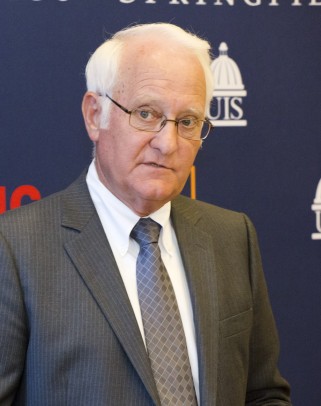UI president: public higher education at crossroads

Bob Easter: the University of Illinois is a $5 billion operation. Photo: L. Brian Stauffer/UI Urbana-Champaign News Bureau
Bob Easter posed a basic question: Why do universities exist?
In a wide-ranging talk that became personal at one point, the University of Illinois president addressed the City Club of Chicago June 26.
“I believe the answer begins with a couple of characteristics that define us as human beings — an insatiable curiosity and a unique ability to transmit knowledge from one generation to the next,” he told an audience of Chicago civic, business and government leaders.
The modern western university, a product of the Middle Ages, spawned a curriculum that focused on classical literature for the sons of the ruling elite, Easter said.
But “pragmatists began to question the value of a classical education in a world where practical knowledge was critical to the solution of everyday problems,” he said.
So when, during the Civil War, Congress passed the Morrill Act, granting public lands to sell for establishment of universities, it gave this reason:
“… to teach such branches of learning as are related to agriculture and the mechanic arts … in order to promote the liberal and practical education of the industrial classes in the several pursuits and professions in life.”
Easter noted that the U of I is one of the world’s premier public research universities.
“We are a $5 billion operation,” he said.
He offered three more facts:
• for each of the last two years, the three campuses have awarded a record-high 20,000-plus degrees
• enrollment is up 15 percent from a decade ago, and graduates are up 30 percent
• for the semester beginning this fall, the three campuses received nearly five times more applications than available seats in freshman classes.
“Those are some important statistics,” Easter said. “But the question remains: why do we do the work that we do?”
Before the Land-Grant Act, there was no concept of education as something that benefited society as a whole, he said.
Afterwards, “young people, such as myself, were able to escape from limited circumstances and enjoy an incredible life,” he said.
Continuing in a personal vein, Easter flashed an old photo on the screen and said, “the young man on the image is your speaker, at the age of 14, on a remote, struggling farm in Southwest Texas, along the border with Mexico.
“The trajectory of my life changed because of access to a very affordable, publicly funded community college — $47 a semester. And a very affordable baccalaureate and master’s education at Texas A&M — $500 a semester. And a top-flight doctoral program at the University of Illinois.”
Easter said he believes public higher education is at a crossroads.
In 1973, the year he arrived on the Urbana campus, median household income in Illinois was about $10,500 and in-state tuition and fees at Urbana were $686 a year.
A family could send its child to the university for about 6.5 percent of family income, he said.
Today, 40 years later, median household income is about $50,600, and in-state tuition and fees for a freshman this fall will be nearly $15,200. That’s 30 percent of median family income.
“We cannot afford to ignore the need for public investment in higher education — and the K-12 education that precedes it,” Easter said.
In the early ’50s, federal and state governments began to invest heavily in support of research in university laboratories, he noted.
“The funding mechanism that accelerated [higher education’s] rise is breaking down — a victim of the era of constrained government resources in which we now live,” Easter said.
“Direct state funding that once covered nearly half of the U of I’s day-to-day costs now accounts for less than 15 percent.
“In inflation-adjusted dollars, that has reduced state funding to 1965 levels — when we enrolled half as many students as today.
“Tuition has increased sharply to plug the gap, and that is not sustainable.”
In 2012, the university Board of Trustees established a policy that holds tuition increases to the rate of inflation.
“As a result,” Easter said, “tuition will increase only 1.7 percent for incoming freshmen next fall — the smallest increase in nearly two decades.”
However, that will “inevitably” cut dollars to support the university and its academic and research programs, he said.
The U of I’s federal funding is sixth-highest in the nation, and the university is first in support from the National Science Foundation and among leading institutions in the amount of funding from the National Institutes of Health, Easter pointed out.
“And our research discovery doesn’t just sit dormant in some journal,” he said. “We put it to work to serve society and drive economic growth for our state and nation.”
Urbana’s research park has incubated 145 start-up companies and a similar small-business incubator is growing in Chicago, “already working with more than 30 companies to spin out high-tech start-ups from our UIC campus,” he said.
What will the public university of the future look like? Easter listed these “essential components”:
• reliance on technology “in a way we cannot imagine today”
• emphasis on philanthropy for costs formerly covered by federal and state governments
• partnership between public entities, higher ed institutions and industry to spur innovation and foster research.
• enhancing the student experience, both in and outside the classroom, with internships, study abroad, service learning and on-campus residential experience “to develop the cultural competencies increasingly needed in our global society.”
